人教版(2019) 选择性必修 第二册 Unit 5 First Aid Video Time 课件 (29张,含视频)
文档属性
| 名称 | 人教版(2019) 选择性必修 第二册 Unit 5 First Aid Video Time 课件 (29张,含视频) |
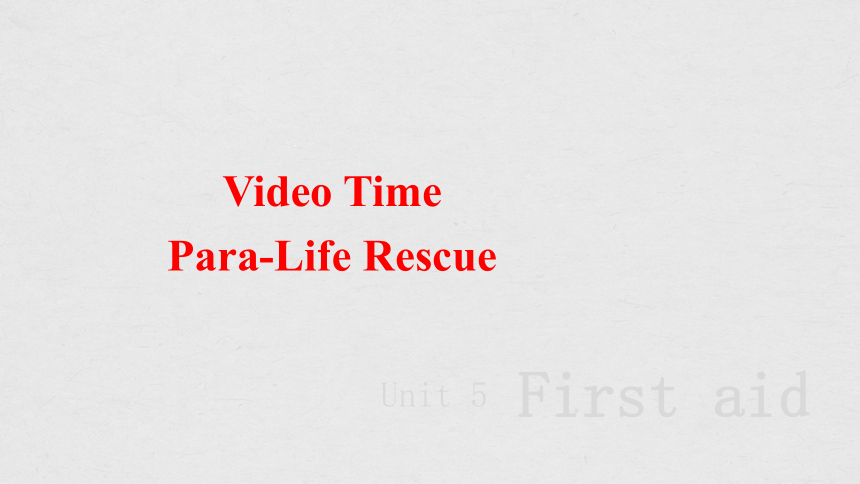
|
|
| 格式 | pptx | ||
| 文件大小 | 68.4MB | ||
| 资源类型 | 教案 | ||
| 版本资源 | 人教版(2019) | ||
| 科目 | 英语 | ||
| 更新时间 | 2024-04-05 21:56:09 | ||
图片预览

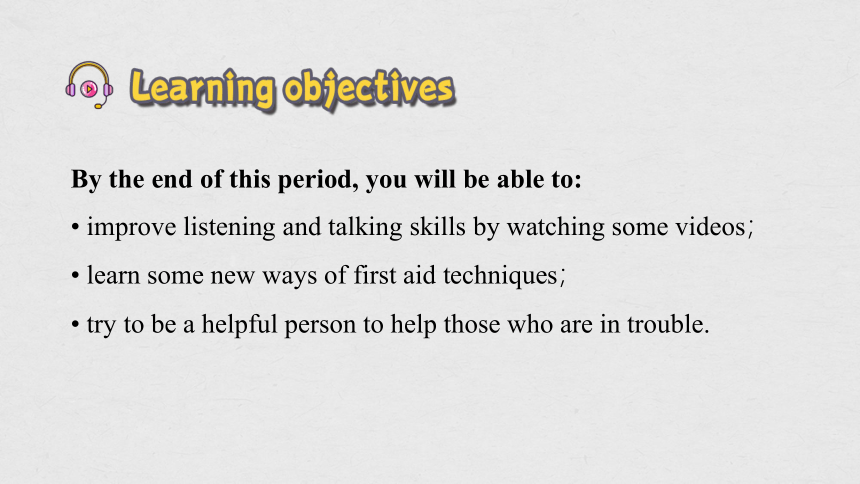
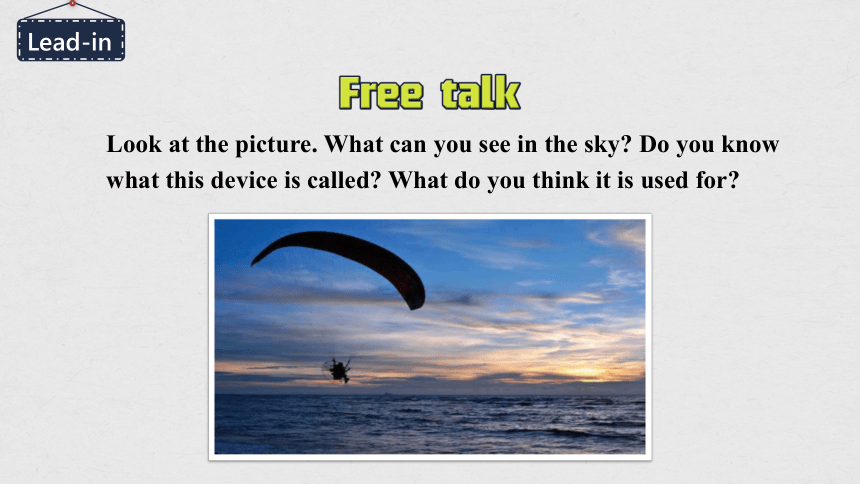
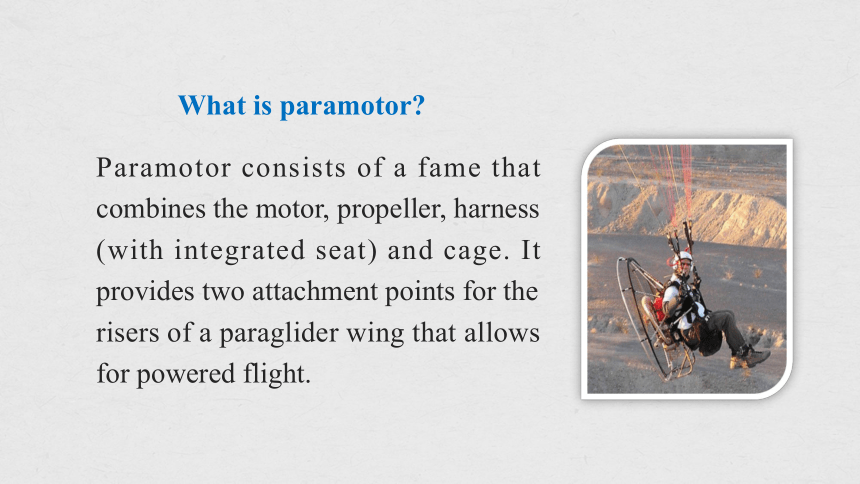
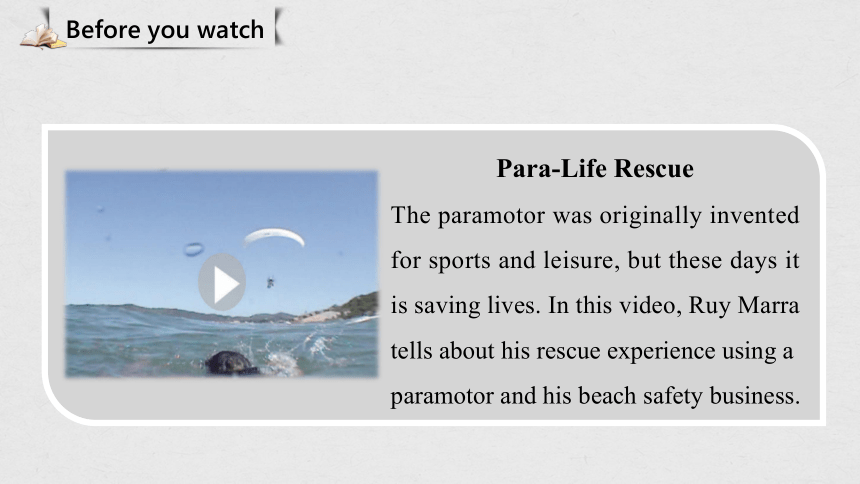
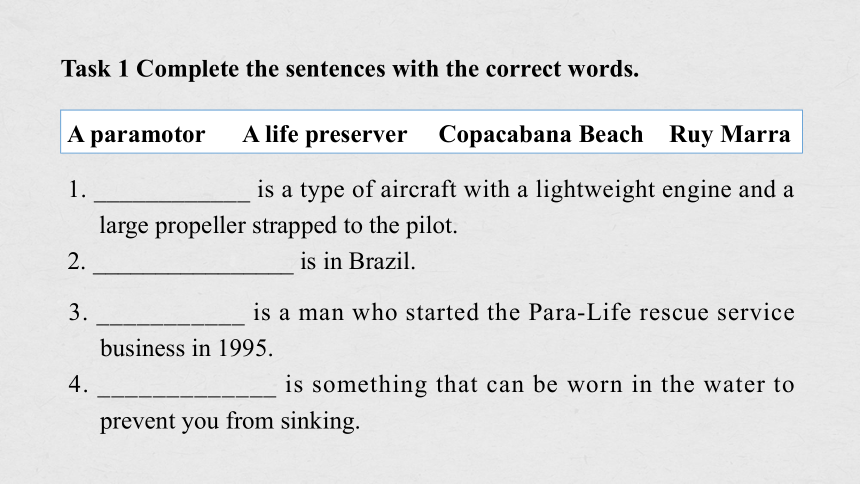
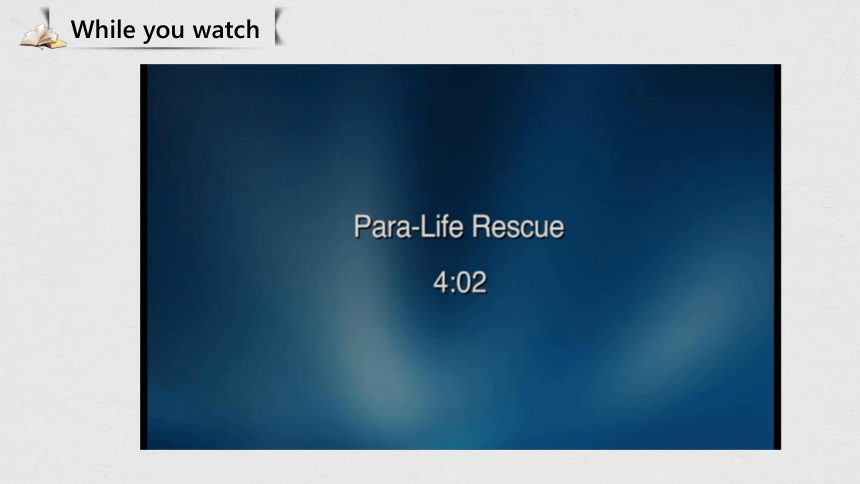
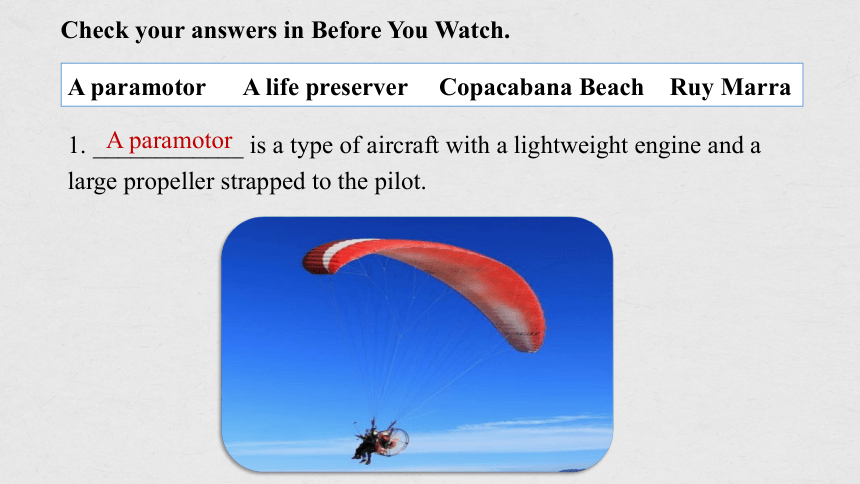
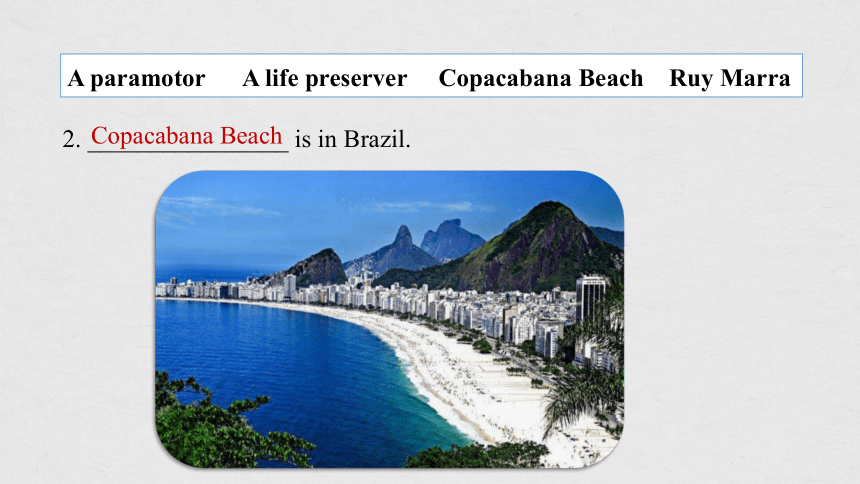
文档简介
(共29张PPT)
Video Time
Para-Life Rescue
Unit 5
First aid
By the end of this period, you will be able to:
improve listening and talking skills by watching some videos;
learn some new ways of first aid techniques;
try to be a helpful person to help those who are in trouble.
Lead-in
Look at the picture. What can you see in the sky Do you know what this device is called What do you think it is used for
What is paramotor
Paramotor consists of a fame that combines the motor, propeller, harness (with integrated seat) and cage. It provides two attachment points for the risers of a paraglider wing that allows for powered flight.
Before you watch
Para-Life Rescue
The paramotor was originally invented for sports and leisure, but these days it is saving lives. In this video, Ruy Marra tells about his rescue experience using a paramotor and his beach safety business.
1. ____________ is a type of aircraft with a lightweight engine and a large propeller strapped to the pilot.
2. ________________ is in Brazil.
Task 1 Complete the sentences with the correct words.
A paramotor A life preserver Copacabana Beach Ruy Marra
3. ___________ is a man who started the Para-Life rescue service business in 1995.
4. _____________ is something that can be worn in the water to prevent you from sinking.
While you watch
1. ____________ is a type of aircraft with a lightweight engine and a large propeller strapped to the pilot.
A paramotor
A paramotor A life preserver Copacabana Beach Ruy Marra
Check your answers in Before You Watch.
2. ________________ is in Brazil.
Copacabana Beach
A paramotor A life preserver Copacabana Beach Ruy Marra
3. ___________ is a man who started the Para-Life rescue service business in 1995.
Ruy Marra
A paramotor A life preserver Copacabana Beach Ruy Marra
4. _____________ is something that can be worn in the water to prevent you from sinking.
A life preserver
A paramotor A life preserver Copacabana Beach Ruy Marra
1. Marra has a staff of twenty people working for him. T / F
2. Marra’s company has saved the lives of more than eighty people. T / F
3. Marra did not need government approval to set up his company. T / F
4. Marra communicates with the paramotor pilots through two-way radios. T / F
5. A rip current is a dangerous flow of water that moves away from the beach. T / F
Task 2 Decide if the following statements are true (T) or false (F).
1. ( ) Marra has a staff of twenty people working for him.
T
Check your answers.
2. ( ) Marra’s company has saved the lives of more than eighty people.
T
3. ( ) Marra did not need government approval to set up his company.
F
4. ( ) Marra communicates with the paramotor pilots through two-way
radios.
F
5. ( ) A rip current(离岸流,裂流) is a dangerous flow of water that moves away from the beach.
T
___ The pilot calls the lifeguards.
___ The pilot manoeuvres close enough to drop the life preserver to the swimmer.
___ The pilot sees a victim.
___ Para-Life pilots strap themselves into the paramotor.
___ The pilot then continues to fly above the victim until the lifeguards arrive.
___ The pilot flies against the wind to reduce flight speed.
Task 3 Number the following steps in the correct order.
___ The pilot calls the lifeguards.
___ The pilot manoeuvres close enough to drop the life preserver to the swimmer.
___ The pilot sees a victim.
___ Para-Life pilots strap themselves into the paramotor.
___ The pilot then continues to fly above the victim until the lifeguards arrive.
___ The pilot flies against the wind to reduce flight speed.
3
5
2
1
6
4
Check your answers.
Narrator: The Brazilian city of Rio de Janeiro—or Rio, as it is commonly known—is one of the most beautiful cities in the world. Its combination of impressive coastline with absolutely stunning mountains attracts people from all over the world.
Sports like paragliding have long been very popular in this beautiful coastal region, and now there is a new type of glider in town. It’s called the paramotor. It consists of a lightweight engine and a large propeller. Both are strapped to the back of the pilot. The aircraft was originally invented for sports and leisure, but these days it’s saving lives. The use of paramotors for search-and-rescue began several years ago when Brazilian paragliding champion and instructor Ruy Marra was flying a tour over Copacabana Beach in Rio.
Ruy Marra: I was flying over Copacabana Beach in 1995, doing (an) advertisement for a company with (a) paramotor, when I saw a woman drowning under me. And then I was very worried, I (had) a life preserver for myself, and then I had the idea to use (it and) to gave (it to) her. So I put it on my leg, I came down, because it is easier to manoeuver the paramotor. I shouted (to) her, and then I gave her the life preserver. That’s the way it was (with) the first rescue in the world with (a) paramotor.
Read together
Narrator: Since that first rescue, Marra has founded a private business and developed the Para-Life Rescue System into an important component of beach safety all around Brazil. Over the past few years, his staff of 20 people has been responsible for over 80 rescues. Para-life pilots are now often cheered as they take off and land.
Initially, Marra had to receive government approval for his Para-life business. He also had to get a cooperation agreement from the lifeguard association. The lifeguards turned out to be big fans of the system. They work with the Para-life teams by communicating through two-way radios. This has greatly expanded the lifeguards’ search- and-rescue capabilities.
Lifeguard: It is a great help to us, because it really helps to have an aerial view of the beach and the swimmers offshore. Once a person is sinking, the paramotor pilot can drop a life preserver to them and sustain them until we get there.
Narrator: Para-life pilots prepare for their flights by strapping themselves into a lightweight but powerful frame. The frame holds the propeller and a small backpack equipped with a life preserver, binoculars and two-way radio. The small motor keeps the pilot in the air for up to 3 hours and allows the aircraft to get down to the water quite rapidly.
Once a victim is discovered, the pilot first calls into the lifeguards. Then, the pilot flies against the wind to reduce flight speed and manoeuvres close enough to drop the life preserver to the swimmer. The pilot then continues to fly above the victim until the lifeguards arrive.
The beaches of Rio can get extremely crowded during the three-month-long high season. During this period, three Para-life teams, with two pilots each, work Saturdays, Sundays and public holidays, as long as the winds are manageable.
To identify the highest-risk areas for swimmers, pilots also look for dangerous rip currents. A rip current is a strong surface flow of water that’s moving towards the sea from nearer to the shore. Para-life pilots can identify them because they are lighter in color than normal waves when seen from above.
Marra is planning to start a Para-life program in Brazil that teaches both essential piloting skills and water rescue skills. He also intends to offer a paramedic course. In the future, Marra is still going to be saving people from drowning at the beach, but if his plans go well, he’ll also be teaching people everywhere how to use the Para-life Rescue System.
Ruy Marra: My long-term idea is to train people in other countries to (do) this, to use the Para-life Rescue System and help the lifeguards, and push down the numbers of people drowning on the beach.
Narrator: Hopefully someday soon, everyone’s beaches can be safer with the Para-life Rescue System.
After you watch
1. What are some advantages of paramotors over traditional forms of water rescue What are some disadvantages
2. As a business, how might the Para-Life rescue service make money Is it right to charge victims for rescue If so, how much should they be charged What if they cannot pay
3. What other interesting or new kinds of rescue are there How do they work
1. What are some advantages of paramotors over traditional forms of water rescue What are some disadvantages
The main advantage is the ability to spot the person who is in trouble and get there quickly. The main disadvantage is that the paramotor cannot land and pick the person up.
2. As a business, how might the Para-Life rescue service make money Is it right to charge victims for rescue If so, how much should they be charged What if they cannot pay
It could make money through a contract with the government. While it does not seem right to charge the victims money, in fact ambulance services, doctors, nurses, and hospitals charge victims money all the time. If people are charged money, it should be based on the time and expense required to rescue them, but that amount is hard to determine. As the victim would be billed after the rescue, if the victim cannot pay, it will be just like any other bill the victim might have.
3. What other interesting or new kinds of rescue are there How do they work
One kind of rescue involves dogs that can sniff out people trapped in buildings after an earthquake. The dog just wanders over the ruined building sniffing the ground. If it smells a person, it makes a sign or begins to bark. Rescuers then know where to dig. As a person can survive for as long as three days without water, so long as the person can breathe and is not too badly injured there is still a good chance of rescue in this situation.
It’s a great honour to save a life.
—Leigh Bardugo
Summary
Surf the Internet for more information about Para-Life Rescue.
Homework
Video Time
Para-Life Rescue
Unit 5
First aid
By the end of this period, you will be able to:
improve listening and talking skills by watching some videos;
learn some new ways of first aid techniques;
try to be a helpful person to help those who are in trouble.
Lead-in
Look at the picture. What can you see in the sky Do you know what this device is called What do you think it is used for
What is paramotor
Paramotor consists of a fame that combines the motor, propeller, harness (with integrated seat) and cage. It provides two attachment points for the risers of a paraglider wing that allows for powered flight.
Before you watch
Para-Life Rescue
The paramotor was originally invented for sports and leisure, but these days it is saving lives. In this video, Ruy Marra tells about his rescue experience using a paramotor and his beach safety business.
1. ____________ is a type of aircraft with a lightweight engine and a large propeller strapped to the pilot.
2. ________________ is in Brazil.
Task 1 Complete the sentences with the correct words.
A paramotor A life preserver Copacabana Beach Ruy Marra
3. ___________ is a man who started the Para-Life rescue service business in 1995.
4. _____________ is something that can be worn in the water to prevent you from sinking.
While you watch
1. ____________ is a type of aircraft with a lightweight engine and a large propeller strapped to the pilot.
A paramotor
A paramotor A life preserver Copacabana Beach Ruy Marra
Check your answers in Before You Watch.
2. ________________ is in Brazil.
Copacabana Beach
A paramotor A life preserver Copacabana Beach Ruy Marra
3. ___________ is a man who started the Para-Life rescue service business in 1995.
Ruy Marra
A paramotor A life preserver Copacabana Beach Ruy Marra
4. _____________ is something that can be worn in the water to prevent you from sinking.
A life preserver
A paramotor A life preserver Copacabana Beach Ruy Marra
1. Marra has a staff of twenty people working for him. T / F
2. Marra’s company has saved the lives of more than eighty people. T / F
3. Marra did not need government approval to set up his company. T / F
4. Marra communicates with the paramotor pilots through two-way radios. T / F
5. A rip current is a dangerous flow of water that moves away from the beach. T / F
Task 2 Decide if the following statements are true (T) or false (F).
1. ( ) Marra has a staff of twenty people working for him.
T
Check your answers.
2. ( ) Marra’s company has saved the lives of more than eighty people.
T
3. ( ) Marra did not need government approval to set up his company.
F
4. ( ) Marra communicates with the paramotor pilots through two-way
radios.
F
5. ( ) A rip current(离岸流,裂流) is a dangerous flow of water that moves away from the beach.
T
___ The pilot calls the lifeguards.
___ The pilot manoeuvres close enough to drop the life preserver to the swimmer.
___ The pilot sees a victim.
___ Para-Life pilots strap themselves into the paramotor.
___ The pilot then continues to fly above the victim until the lifeguards arrive.
___ The pilot flies against the wind to reduce flight speed.
Task 3 Number the following steps in the correct order.
___ The pilot calls the lifeguards.
___ The pilot manoeuvres close enough to drop the life preserver to the swimmer.
___ The pilot sees a victim.
___ Para-Life pilots strap themselves into the paramotor.
___ The pilot then continues to fly above the victim until the lifeguards arrive.
___ The pilot flies against the wind to reduce flight speed.
3
5
2
1
6
4
Check your answers.
Narrator: The Brazilian city of Rio de Janeiro—or Rio, as it is commonly known—is one of the most beautiful cities in the world. Its combination of impressive coastline with absolutely stunning mountains attracts people from all over the world.
Sports like paragliding have long been very popular in this beautiful coastal region, and now there is a new type of glider in town. It’s called the paramotor. It consists of a lightweight engine and a large propeller. Both are strapped to the back of the pilot. The aircraft was originally invented for sports and leisure, but these days it’s saving lives. The use of paramotors for search-and-rescue began several years ago when Brazilian paragliding champion and instructor Ruy Marra was flying a tour over Copacabana Beach in Rio.
Ruy Marra: I was flying over Copacabana Beach in 1995, doing (an) advertisement for a company with (a) paramotor, when I saw a woman drowning under me. And then I was very worried, I (had) a life preserver for myself, and then I had the idea to use (it and) to gave (it to) her. So I put it on my leg, I came down, because it is easier to manoeuver the paramotor. I shouted (to) her, and then I gave her the life preserver. That’s the way it was (with) the first rescue in the world with (a) paramotor.
Read together
Narrator: Since that first rescue, Marra has founded a private business and developed the Para-Life Rescue System into an important component of beach safety all around Brazil. Over the past few years, his staff of 20 people has been responsible for over 80 rescues. Para-life pilots are now often cheered as they take off and land.
Initially, Marra had to receive government approval for his Para-life business. He also had to get a cooperation agreement from the lifeguard association. The lifeguards turned out to be big fans of the system. They work with the Para-life teams by communicating through two-way radios. This has greatly expanded the lifeguards’ search- and-rescue capabilities.
Lifeguard: It is a great help to us, because it really helps to have an aerial view of the beach and the swimmers offshore. Once a person is sinking, the paramotor pilot can drop a life preserver to them and sustain them until we get there.
Narrator: Para-life pilots prepare for their flights by strapping themselves into a lightweight but powerful frame. The frame holds the propeller and a small backpack equipped with a life preserver, binoculars and two-way radio. The small motor keeps the pilot in the air for up to 3 hours and allows the aircraft to get down to the water quite rapidly.
Once a victim is discovered, the pilot first calls into the lifeguards. Then, the pilot flies against the wind to reduce flight speed and manoeuvres close enough to drop the life preserver to the swimmer. The pilot then continues to fly above the victim until the lifeguards arrive.
The beaches of Rio can get extremely crowded during the three-month-long high season. During this period, three Para-life teams, with two pilots each, work Saturdays, Sundays and public holidays, as long as the winds are manageable.
To identify the highest-risk areas for swimmers, pilots also look for dangerous rip currents. A rip current is a strong surface flow of water that’s moving towards the sea from nearer to the shore. Para-life pilots can identify them because they are lighter in color than normal waves when seen from above.
Marra is planning to start a Para-life program in Brazil that teaches both essential piloting skills and water rescue skills. He also intends to offer a paramedic course. In the future, Marra is still going to be saving people from drowning at the beach, but if his plans go well, he’ll also be teaching people everywhere how to use the Para-life Rescue System.
Ruy Marra: My long-term idea is to train people in other countries to (do) this, to use the Para-life Rescue System and help the lifeguards, and push down the numbers of people drowning on the beach.
Narrator: Hopefully someday soon, everyone’s beaches can be safer with the Para-life Rescue System.
After you watch
1. What are some advantages of paramotors over traditional forms of water rescue What are some disadvantages
2. As a business, how might the Para-Life rescue service make money Is it right to charge victims for rescue If so, how much should they be charged What if they cannot pay
3. What other interesting or new kinds of rescue are there How do they work
1. What are some advantages of paramotors over traditional forms of water rescue What are some disadvantages
The main advantage is the ability to spot the person who is in trouble and get there quickly. The main disadvantage is that the paramotor cannot land and pick the person up.
2. As a business, how might the Para-Life rescue service make money Is it right to charge victims for rescue If so, how much should they be charged What if they cannot pay
It could make money through a contract with the government. While it does not seem right to charge the victims money, in fact ambulance services, doctors, nurses, and hospitals charge victims money all the time. If people are charged money, it should be based on the time and expense required to rescue them, but that amount is hard to determine. As the victim would be billed after the rescue, if the victim cannot pay, it will be just like any other bill the victim might have.
3. What other interesting or new kinds of rescue are there How do they work
One kind of rescue involves dogs that can sniff out people trapped in buildings after an earthquake. The dog just wanders over the ruined building sniffing the ground. If it smells a person, it makes a sign or begins to bark. Rescuers then know where to dig. As a person can survive for as long as three days without water, so long as the person can breathe and is not too badly injured there is still a good chance of rescue in this situation.
It’s a great honour to save a life.
—Leigh Bardugo
Summary
Surf the Internet for more information about Para-Life Rescue.
Homework
